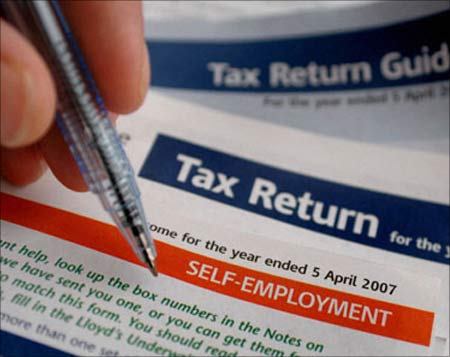Photographs: Mansi Thapliyal/Reuters Vrishti Beniwal in New Delhi
After the income tax department, the excise and service tax department plans to use information from third-party sources to match with its own data and assess reasons for unsatisfactory tax collections from some sectors.
“If other indicators for some sectors are doing well, we can compare those with tax data and see why the revenue from that particular sector is not keeping pace,” said a finance ministry official.
The Central Board of Excise & Customs will develop the process over the next few months.
This will help enforce tax compliance and widen the base.
. . .
Slipping indirect tax collection under scanner
Image: In the case of excise, it has set up a study group to check leakages in Cenvat credit.Photographs: Reuters
Another official said the information technology capability was largely available.
Strengthening the processes would help in intelligence and audit work.
For instance, if automobile sales during a particular period have shown robust increase but excise collections from the sector had not, one would have to analyse where the problem was and how to address it.
Besides industry data, CBEC is using data from the I-T department based on the returns and other documents filed with it to widen the tax base, particularly in service tax.
In the case of excise, it has set up a study group to check leakages in Cenvat credit. Many taxpayers set off their final tax liability against the tax paid on inputs.
Thus, the duty payment in cash comes down.
. . .
Slipping indirect tax collection under scanner
Image: The estimate in the Budget at the start of the financial year was Rs 5,65,002 crore (Rs 5,650,02 billion).Photographs: Illustration by Uttam Ghosh/Rediff.com
“Tax collections should reflect the health of a particular sector but there can be exceptions where production has increased but a lot of credit is lying around because of huge capital investment.
“Something similar had happened in the telecom sector.
“If they (CBEC) do it (matching data) at a macro level, it is good but if they go micro, it won’t help anyone,” said Bipin Sapra, tax partner, EY.
From provisional figures, indirect tax receipts, including customs, excise and service tax, fell short of the 2013-14 revised estimate of Rs 5,19,520 crore (Rs 5195.2 billion) by about Rs 17,000 crore (Rs 170 billion).
The estimate in the Budget at the start of the financial year was Rs 5,65,002 crore (Rs 5,650,02 billion).
. . .
Slipping indirect tax collection under scanner
Image: An Advanced Passenger Information System will be hastened to check tax evasion on customs duty.Photographs: Illustration by Uttam Ghosh/Rediff.com
The interim Budget target for this financial year is Rs 6,17,377 crore (Rs 6,173.77 billion).
The shortfall was due to a slowing in the economic activity.
“We have also moved a proposal for a committee that would give us the road map for improved IT infrastructure to encourage voluntary compliance, business intelligence and analytics,” the official said.
An advanced analytics centre would be set up to maximise collections.
An Advanced Passenger Information System will be hastened to check tax evasion on customs duty.
It also enhances border security by providing officers with pre-arrival and departure data on all passengers.
. . .
Slipping indirect tax collection under scanner
Image: The I-T department uses third-party information from sources such as the Annual Information Return, Central Information Branch and the Centralised Processing Centre for Tax Deducted at Source to check for tax compliance.Photographs: Illustration by Uttam Ghosh/Rediff.com
Earlier, the tax authorities had started a project called ‘Tax 360’.
Under this, the sales tax department of the Maharashtra government used the data available with various central agencies to get information on evaders by monitoring transactions such as foreign travel and high value purchases.
More states had later asked the Centre to provide such data.
The I-T department uses third-party information from sources such as the Annual Information Return, Central Information Branch and the Centralised Processing Centre for Tax Deducted at Source to check for tax compliance.
. . .







article